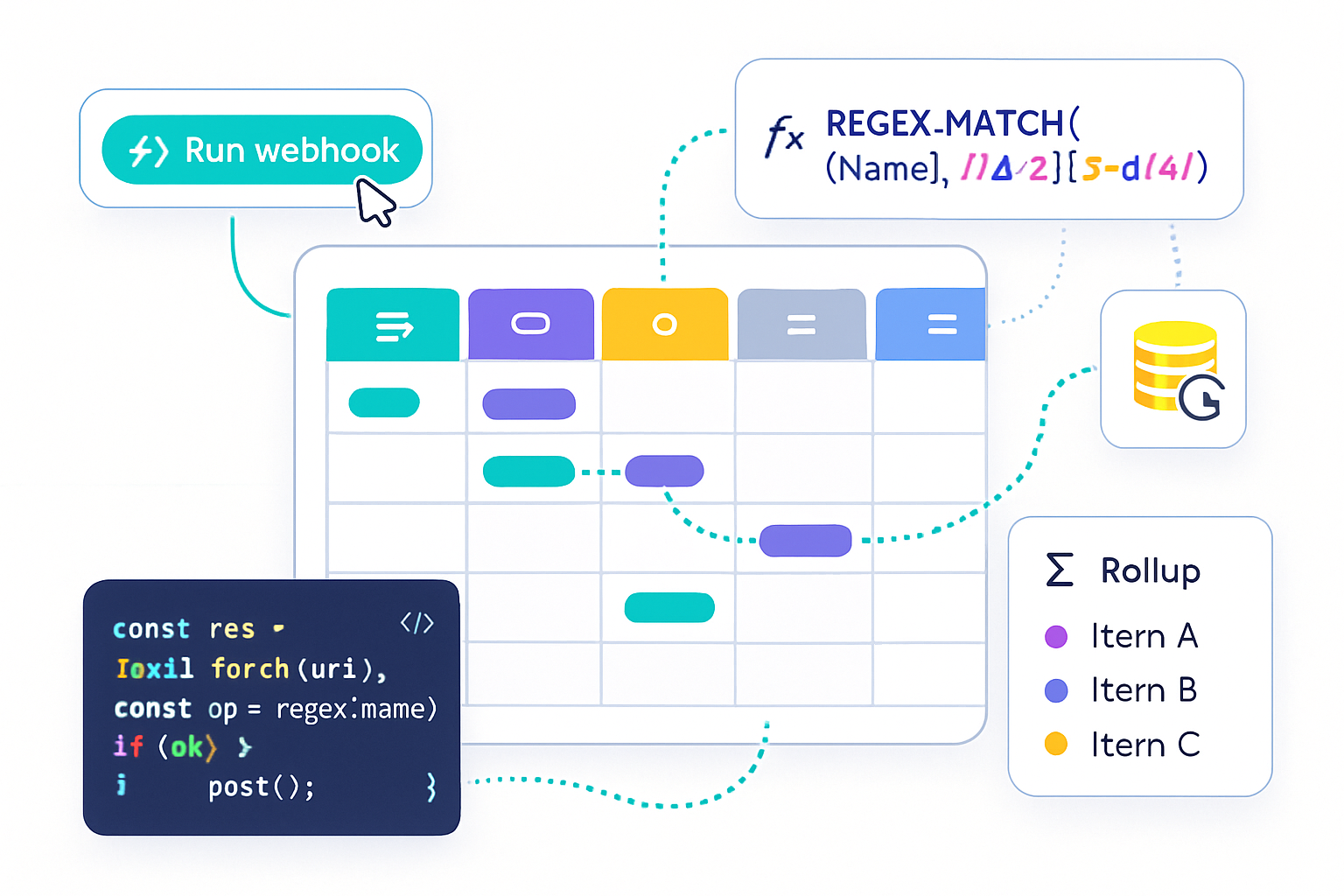· productivity · 8 min read
10 Lesser-Known Make Features That Will Revolutionize Your Workflow
Discover 10 underused Make features - from Data Stores to advanced HTTP calls, aggregators to error handlers - and learn practical recipes and tips to automate tasks you never thought possible.

Outcome first: by the time you finish this article you’ll have ten concrete, ready-to-apply Make techniques that let you process huge datasets, call obscure APIs, handle errors gracefully, and batch actions - often without writing any code.
Hook: want fewer manual fixes, fewer API-limit headaches, and fewer scattered scripts? Keep reading.
Why these features matter
Make is powerful out of the box. But the features below let you move from “it works” to “it hums” - more efficient, more reliable, and often far cheaper (fewer scenario runs, fewer API calls). I’ll show what each feature does, when to use it, a short how-to you can replicate, common pitfalls, and a couple of combo recipes so you can start automating smarter immediately.
1) Custom Webhooks: instant, flexible, and verifiable
What it does: Receive data from any external system instantly via a custom webhook. Not just JSON - you can accept raw bodies, multipart/form-data, and verify signatures.
When to use: Replace polling-heavy watchers, get instant events from apps that support webhooks, or accept form uploads.
Quick how-to:
- Add a Webhooks > Custom webhook module.
- Create a new webhook and copy the URL.
- Configure the sender (app, script, or form) to POST to that URL. If the sender supports signatures, capture the header and use Make formulas to verify it.
Tips & pitfalls:
- Use signature verification for security - compute HMAC on your side and compare with incoming header using Make’s functions.
- Watch out for large payloads - if you expect big files, use multipart handling or presigned URLs to avoid timeouts.
Combine with: HTTP module to fetch additional data after receiving a small webhook payload.
References: Make Webhooks docs
2) HTTP module: your universal API tool
What it does: Make custom API calls with any method, headers, body type, and authentication scheme.
When to use: Integrate with apps that don’t have native modules, handle custom OAuth flows, or implement complex pagination and rate-limit logic.
Quick how-to:
- Add the HTTP > Make a request module.
- Set method, URL, headers, and body. Use formulas for dynamic values.
- For APIs with pagination - loop with a Router + Iterator + HTTP calling the next_page link.
Tips & pitfalls:
- Respect rate limits - implement Sleep and exponential backoff in an error handler.
- Use query parameters and caching (Data Store) to avoid duplicate calls.
Combine with: Data Store to cache API results and Aggregator to batch POSTs.
References: Make HTTP docs
3) Data Store: a tiny, persistent database inside Make
What it does: Store, retrieve, and query small records across scenario runs.
When to use: Deduplicate incoming webhooks, cache API responses, track processed IDs, or store state between runs without an external DB.
Quick how-to:
- Create a Data Store in Make’s sidebar.
- Use the Data Store modules (Create/Update/Search/Get/Delete) inside your scenario.
- Use a unique key (email, external ID) to prevent duplicates.
Tips & pitfalls:
- Don’t use Data Store for massive datasets - it’s optimized for lightweight state.
- Store hashes instead of full payloads if you only need dedupe capability.
Combine with: Webhook + Data Store to build idempotent receivers.
References: Make Data Store docs
4) Aggregator and Array Aggregator: batch like a pro
What it does: Collect multiple bundles into one array/bundle so you can perform bulk operations (e.g., send 50 records in one API call).
When to use: Reduce API calls, create bulk CSVs, or build a single report from many small events.
Quick how-to:
- Insert Tools > Aggregator (or Array Aggregator) after a Watch module.
- Configure grouping rules and max items or timeout.
- Send the aggregated array to your target module (HTTP POST, Google Sheets, etc.).
Tips & pitfalls:
- Choose size vs latency - larger batch sizes reduce calls but increase wait time.
- Add a timeout so small traffic still gets processed.
Combine with: Iterator for post-processing and Data Store to re-try failed batches.
References: Make Aggregator docs
5) Iterator / Split Collection: process collections as individual bundles
What it does: Turn an array into multiple bundles - one per item - so each element can flow independently through the scenario.
When to use: When you must call an API per item (e.g., update 1,000 users), or when parallel processing simplifies logic.
Quick how-to:
- Use Tools > Iterator or Split Collection on an array field.
- Connect downstream modules; each item becomes a separate run bundle.
Tips & pitfalls:
- Combine with routers to apply different logic per item.
- Beware of API rate limits - use Sleep or batching to avoid throttling.
Combine with: Aggregator to re-batch processed results back into a single payload.
References: Make Iterator docs
6) Router: conditional branching and fan-out
What it does: Send bundles down multiple conditional paths in a single scenario. Each route can have its own filters and modules.
When to use: Multi-channel delivery (email vs SMS), applying different business rules, or splitting work for parallel execution.
Quick how-to:
- Add a Router module and create routes.
- Attach filters to routes using simple expressions (e.g., status = “urgent”).
Tips & pitfalls:
- Routes execute independently - remember to converge state if you need an overall result.
- Use a final merge step (Aggregator) when you need to collect outputs.
Combine with: Iterator to fan-out per-item processing and Aggregator to gather results.
References: Make Router docs
7) Flow-control modules: Sleep, Repeater, and Limiters
What it does: Pause execution (Sleep), retry logic (Repeater), and control throughput to avoid hitting API rate limits.
When to use: Space out requests, implement backoff, or repeat checks until a condition is true.
Quick how-to:
- Insert Tools > Sleep to pause for seconds/minutes.
- Use Repeater to attempt an operation multiple times with pauses.
Tips & pitfalls:
- Use short sleeps plus capped retries for resilient APIs.
- Avoid very long scenarios - for long waits prefer stateful design with Data Store and scheduled triggers.
Combine with: HTTP + Error handlers for graceful retry on 429/5xx statuses.
References: Make Flow Control docs
8) Error Handlers and On-Error routes: fail elegantly
What it does: Trap errors, choose per-module behavior (ignore, continue, record and stop, rollback), and build custom retry or notification flows.
When to use: Avoid crashing a whole scenario due to one bad record, add exponential backoff, or alert on repeat failures.
Quick how-to:
- Click the module’s three-dot menu > Set up an error handler.
- Choose actions - Ignore, Re-run scenario, or route to alternative modules.
Tips & pitfalls:
- Use Ignore sparingly - you might hide systemic problems.
- Prefer explicit retry logic with exponential backoff for transient API errors.
Combine with: Data Store + Aggregator to store failed records for manual review or later reprocessing.
References: Make Error Handling docs
9) Scenario variables, constants and Secret fields: centralized configuration
What it does: Store scenario-wide values (API keys, thresholds, toggles) in one place so you can change behavior without editing the scenario flow.
When to use: Manage multiple environments (test vs prod), update time windows or feature flags, and avoid hardcoding values in many modules.
Quick how-to:
- Use the Scenario settings to add variables or use Make’s Secrets for credentials.
- Reference these variables in any module via the mapping dialog or formulas.
Tips & pitfalls:
- Keep secrets out of descriptions and logs.
- Use meaningful names and document expected formats (e.g., ISO date, integer)
Combine with: Scheduling and conditional routes to implement feature toggles and maintenance windows.
References: Make Variables & Secrets docs
10) Tools - Parse JSON, Regex, CSV, and Make formulas: transform anything
What it does: Clean, parse, reformat, and compute values inside Make using built-in tools and formula expressions.
When to use: Parse incoming JSON, extract text with regex, create CSV blobs, or compute hash/signatures.
Quick how-to:
- Use Tools > Parse JSON to safely extract nested fields.
- Use Text > Regex to capture groups from messy text.
- Use the built-in formula editor to combine date math, conditional logic, base64, or HMAC calculation.
Tips & pitfalls:
- Always validate with sample inputs - regex and JSON structures vary.
- Keep complex formulas readable by documenting steps in module descriptions.
Combine with: Webhooks + HTTP to verify signed payloads and then transform them into pretty reports.
Example recipes - put it all together
Recipe A: Idempotent webhook-to-CRM sync (avoid duplicates)
- Webhook receives event → Data Store Search for external_id → If not found, HTTP POST to CRM → Store external_id in Data Store.
- Error Handler retries HTTP on 429 with Sleep backoff; failed items are aggregated into a “failed.csv” and emailed to ops.
Recipe B: Large CSV import with API rate limits
- Watch a new CSV file (cloud storage) → Parse CSV → Array Aggregator chunked into groups of 50 → HTTP batch POST each chunk → On 429, Sleep + Repeater and re-try per chunk.
Recipe C: Multi-channel alerting with enrichment
- Webhook alert → HTTP enrich with third-party API → Router - if high severity send SMS, otherwise email → Aggregator daily summary for reporting.
Performance and cost tips
- Batch when possible (Aggregator) to reduce scenario executions.
- Cache stable API responses in Data Store to cut duplicate requests.
- Use Webhooks and instant triggers instead of polling to save runs.
- Monitor scenario run time; long-running sleeps may increase consumption - prefer stateful resumption with Data Store and scheduled triggers for very long waits.
Final checklist to get started (copy & paste)
- Replace a polling watcher with a custom Webhook.
- Add Data Store dedupe to one scenario.
- Turn high-frequency single calls into Aggregator batches.
- Use HTTP for one non-native integration; implement pagination.
- Add an error handler on any module that calls external APIs.
Wrap-up
These ten features are small individually, but together they let you build resilient, efficient, and maintainable automations: instant triggers, smart batching, built-in persistence, elegant error recovery, and flexible transformations. Start by applying one feature to a pain point you already have - a noisy webhook, an API limit, or a recurring manual task - and you’ll quickly see how Make stops being just “useful” and becomes the backbone of your workflow.
References
- Make Help Center - Webhooks: https://www.make.com/en/help/app/webhooks
- Make Help Center - HTTP module: https://www.make.com/en/help/app/http
- Make Help Center - Data Store: https://www.make.com/en/help/app/data-store



